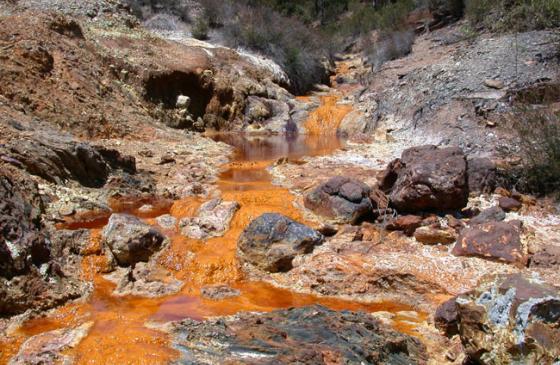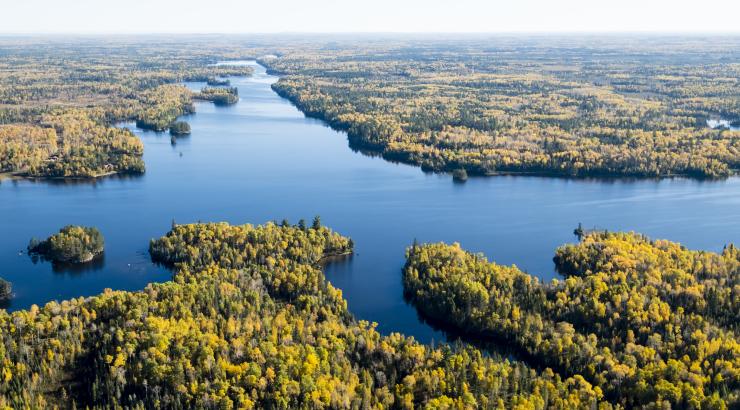Have you ever wondered just how sulfide-ore copper mines pollute their surrounding environments? It’s a good question, because in order to understand the environmental impacts to the Boundary Waters Canoe Area Wilderness and Voyageurs National Park, we must first understand all of the ways sulfide-ore copper mining can cause harm to the surrounding lakes, streams, wetlands and forests. Independent studies show many vectors of pollution, and combined they create a significant risk of contaminating the Boundary Waters.
 Sulfide-ore copper mining is a risky type of mining that has never been done before in Minnesota. No matter the method, sulfide-ore copper mines proposed near the Boundary Waters would extract trace amounts of metals from large volumes of rock. Rock is blasted from pit walls and sorted into metal-bearing ore and waste rock. In the mine's first years, 4.1 million tons of waste rock will be stockpiled on the surface while the mine is hollowed out. The sulfide-bearing ore deemed to be economically valuable is crushed to increase surface area and then sent to a surface stockpile before entering the concentrator plant where the metals are chemically extracted. Since less than 1% of the rock contains metals of interest, ninety-nine percent of the rock mined turns out to be economically value-less and will remain in perpetuity in the tailings storage facility, waste rock storage piles and as backfill in the underground mine itself. No metal recovery method is 100% efficient, and metals and sulfides are left behind in the tailings. Tailings also contain residue from the explosives used to blast the pit wall, chemicals used to separate metals from sulfide minerals, and other ore components with little economic value.
Sulfide-ore copper mining is a risky type of mining that has never been done before in Minnesota. No matter the method, sulfide-ore copper mines proposed near the Boundary Waters would extract trace amounts of metals from large volumes of rock. Rock is blasted from pit walls and sorted into metal-bearing ore and waste rock. In the mine's first years, 4.1 million tons of waste rock will be stockpiled on the surface while the mine is hollowed out. The sulfide-bearing ore deemed to be economically valuable is crushed to increase surface area and then sent to a surface stockpile before entering the concentrator plant where the metals are chemically extracted. Since less than 1% of the rock contains metals of interest, ninety-nine percent of the rock mined turns out to be economically value-less and will remain in perpetuity in the tailings storage facility, waste rock storage piles and as backfill in the underground mine itself. No metal recovery method is 100% efficient, and metals and sulfides are left behind in the tailings. Tailings also contain residue from the explosives used to blast the pit wall, chemicals used to separate metals from sulfide minerals, and other ore components with little economic value.
When sulfide minerals in ore, tailings or waste rock are exposed to air and water, acid mine drainage develops. Oxidation and hydrolysis reactions turn otherwise benign minerals into toxic materials, including acid, metals (e.g., mercury, copper, nickel, lead and zinc) and sulfates (Jennings et al. 2008). Acidic conditions further catalyze these reactions, making them proceed at faster rates than would otherwise occur (Jennings et al. 2008).
The sulfide-ore copper mining industry has a disastrous track record. A peer-reviewed report prepared by Earthworks studied fourteen sulfide-ore copper mines representing 89% of current U.S. copper production. Of those fourteen mines, all had experienced some sort of pipeline spill or other accidental release. Thirteen of the fourteen (92%) had experienced water collection and treatment failures that resulted in significant impacts to water quality. The tailings dam failure at the Mount Polley Mine in British Columbia in August 2014 shows the catastrophic potential for such failures (Earthworks 2012).
Run-of-the-mill pipeline leaks and seepage from underground mine sites are also serious vectors for contamination as shown by Dr. Tom Myers, a hydrology consultant who has studied the preliminary plans for mines proposed near the Boundary Waters. The Twin Metals pre-feasibility study calls for a massive network of pipelines to dispose of sulfide-, metal- and chemical- laden tailings. Half of the tailings would be piped from the 1,000-acre concentrator facility on the shore of Birch Lake; the other half would be piped back underground. Based on industry history (Earthworks 2012) and the danger of northeastern Minnesota’s extreme cold freezing and blocking pipes, this pipeline network carries a high risk of failure.
In addition to tailings dam failures and pipeline leaks, sulfide-ore copper mines can pollute through seepage from underground pits and surface waste rock and sulfide-bearing ore. These pollution vectors are hard to detect and difficult to fix. By exposing sulfides minerals in the pit walls to oxygen and water, they are able to produce acid mine drainage. Cracks in the bedrock connecting the underground mine to groundwater can then transmit the generated acid mine drainage to streams, lakes, and some wetlands. It is reasonable to expect that underground seepage of pollutants from the Spruce Road deposit owned by Twin Metals would eventually penetrate the Boundary Waters, according to modeling conducted by Dr. Myers. Any surface storage of waste rock, tailings and sulfide-bearing ore also creates the opportunity for water bearing acid, heavy metals, or sulfates to seep into groundwater despite engineered liners designed to contain them. All liners leak to some extent, and no liner has been tested over the decades and centuries required to permanently protect the Boundary Waters from pollution from sulfide-ore copper mining.
In light of the combined facts that sulfide-ore copper mining on the edge of the Boundary Waters would likely contaminate the Boundary Waters and surrounding lakes, rivers and streams, and that the industry has a poor track record of preventing water quality impacts, it is clear that sulfide-ore copper mining would be too risky for the Boundary Waters Canoe Area Wilderness and Voyageurs National Park.
References
Earthworks. 2012. "U.S. Copper Porphyry Mines Report: The Track Record of Water Quality Impacts Resulting from Pipeline Spills, Tailings Failures and Water Collection and Treatment Failures." Earthworks, Washington, DC.
Jennings, S.R., Neuman, D.R. and Blicker, P.S. 2008. "Acid Mine Drainage and Effects on Fish Health and Ecology: A Review." Reclamation Research Group Publication, Bozeman, MT.
[TOP PHOTO: Carol Stoker, NASA; ]
Rachel Garwin is the Campaign's policy director. She holds an M.S. in Natural Resources from the University of Vermont. Every month, Science Desk will include our latest scientific support and share a deeper understanding of the potential environmental impact from sulfide-ore copper mining near the Boundary Waters.



